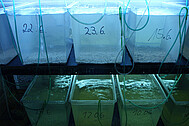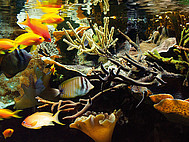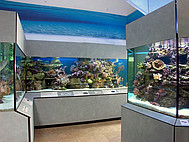A glimpse behind the scenes
The Vivarium is where visitors can see impressions of our underwater worlds, rain forests and savannas. The technical equipment needed to maintain these artificial habitats is kept out of the public view and located "behind the scenes" in special rooms.
Warming lights and UV lamps have been installed over the terrariums. There are also heated floors, heatable water tanks and spray systems which all help our amphibians and reptiles feel more at home. Special aquarium lighting with different fluorescent tubes and HQI lights help ensure ideal growing conditions for plants and corals. The tropically warm water is achieved by keeping the room at a higher temperature. By contrast, the water temperature in the Mediterranean aquariums are kept at 15°C by means of convection cooling. Sophisticated filter systems create good water quality for the aquariums, which is especially important in maintaining corals.
The varying kinds of water for the inhabitants of our aquariums are also prepared behind the scenes. Every day a powerful reverse-osmosis water filter yields almost 2000 litres of demineralised water which is used as spray, put in the soft-water aquariums or turned into salt water.
Visitors who come to the Vivarium are often surprised by how many animals live behind the scenes. There are many reasons to keep them in a quieter space:
- Animals which are vulnerable to stress can rest here so they can spawn
- Young fish, frogs, lizards and snakes can grow in peace
- Animals that fight are separated
- Injuries and illnesses are treated
- Newly acquired animals have to be quarantined and examined for pathogens and parasites
Generating enough food is often a complicated process. We raise rats, mice and a variety of insects such as crickets, fruit flies, cockroaches, locusts and darkling beetles, since many reptiles and amphibians only feed on living creatures. Every week we receive a shipment of living opossum shrimps (Mysida) from the North Sea to feed our sea horses. We culture phytoplankton, zooplankton, saltwater copepods and brine shrimp for the lesser creatures which filter plankton as well as for use in raising young sea horses and saltwater fish.









